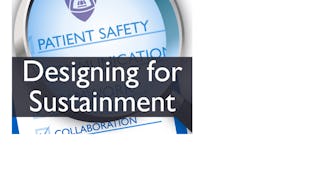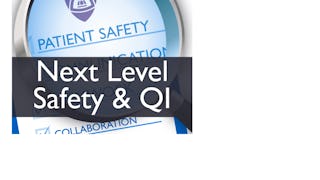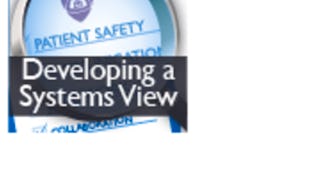Now that you’ve carefully planned your patient safety and quality improvement project, the real work can begin. This course will introduce students to the unique challenges encountered when implementing, maintaining, and expanding a patient safety and quality initiative. Students will learn to apply lessons learned from the 4 E model and TRiP into developing specific aims for their QI project. Additionally, students will develop a plan to address the adaptive and technical challenges in their projects including whether their initiative needs to be submitted to an Institutional Review Board (IRB). Finally, students will develop plans to grow their local QI project into a system-wide project.

Enjoy unlimited growth with a year of Coursera Plus for $199 (regularly $399). Save now.

Implementing a Patient Safety or Quality Improvement Project (Patient Safety V)
This course is part of Patient Safety Specialization

Instructor: David Thompson DNSc, MS, RN
6,764 already enrolled
Included with
(98 reviews)
What you'll learn
Apply the 4 E's model and TRiP into developing your specific aims.
Identify the criteria to determine if a QI project needs to be submitted to the IRB.
Develop a plan to address the adaptive and technical challenges in your project.
Create a plan to turn a local QI project into a system-wide project.
Skills you'll gain
Details to know

Add to your LinkedIn profile
See how employees at top companies are mastering in-demand skills

Build your subject-matter expertise
- Learn new concepts from industry experts
- Gain a foundational understanding of a subject or tool
- Develop job-relevant skills with hands-on projects
- Earn a shareable career certificate

There are 4 modules in this course
In this module, learners will understand the patient safety risk of Venous Thromboembolism in our patient populations and its impact on patient outcomes. Learners will see what can be done to protect patients from this almost entirely preventable harm event including assessing surveillance bias, stakeholder engagement and nursing education to improve quality of care to reduce VTE risk. The learner will also be able to develop a plan to identify the best evidence to support their work when competing national organizations have competing recommendations.
What's included
11 videos1 assignment
In this module we will review the historical perspective of human subject's research and quality improvement research. The learner will become familiar with the history of the IRB in large scale quality improvement initiatives and identify what should be submitted to the IRB before beginning a quality improvement or patient safety project. Further, the learner will become familiar with what can and can't be shared outside the organization without the Risk Management office providing consent.
What's included
6 videos1 assignment
In this module we will introduce you to a quality improvement project that we implemented in two adult Intensive Care Units, to reduce Central line associated blood stream infections. The learner will develop an understanding of using the Translating Evidence into Practice model into action in developing a technical component to improve patient safety. Learners will become familiar with the Comprehensive Unit Based Safety program (CUSP) and the adaptive work used to implement the quality improvement initiative and change management methods that help achieve success.
What's included
9 videos1 assignment
In this module we will introduce you to a quality improvement project that was built following successful implementation of the Central Line Associated Blood Stream Infection program developed and implemented at Johns Hopkins. The learner will see that building momentum from a previous success is possible using proven quality Improvement bundles and the results of the adaptive work using the Comprehensive Unit-Based Safety Program to improve unit based culture. The learner will understand the rigorous preparation and tool development needed to support clinicians when you move a program to another venue. They will develop an understanding of the Collaborative approach that includes on-boarding or immersion into the content, allowing preparation time and providing both content and coaching call that support the teams implementing the initiative. Learners will see how to utilize the CUSP program to meet adaptive challenges. Learners will also see the tool-kit that was developed including the documents necessary to provide support for front line clinicians that we believed necessary for a successful quality improvement and patient safety program.
What's included
11 videos1 peer review
Earn a career certificate
Add this credential to your LinkedIn profile, resume, or CV. Share it on social media and in your performance review.
Instructor

Offered by
Explore more from Healthcare Management
 Status: Free Trial
Status: Free TrialJohns Hopkins University
 Status: Free Trial
Status: Free TrialJohns Hopkins University
 Status: Free Trial
Status: Free TrialJohns Hopkins University
 Status: Free Trial
Status: Free TrialJohns Hopkins University
Why people choose Coursera for their career




Learner reviews
98 reviews
- 5 stars
87.75%
- 4 stars
9.18%
- 3 stars
1.02%
- 2 stars
1.02%
- 1 star
1.02%
Showing 3 of 98
Reviewed on Mar 11, 2025
Excellant Topic and Meticulously designed teaching mentors,Great efforts done by the mentors to explain the topic.
Reviewed on May 22, 2018
Fantastic course content and marvellous mentors. I am very grateful to both mentors and Coursera.
Reviewed on Nov 27, 2020
this course was a bit difficult for me....but i persevered

Open new doors with Coursera Plus
Unlimited access to 10,000+ world-class courses, hands-on projects, and job-ready certificate programs - all included in your subscription
Advance your career with an online degree
Earn a degree from world-class universities - 100% online
Join over 3,400 global companies that choose Coursera for Business
Upskill your employees to excel in the digital economy
Frequently asked questions
To access the course materials, assignments and to earn a Certificate, you will need to purchase the Certificate experience when you enroll in a course. You can try a Free Trial instead, or apply for Financial Aid. The course may offer 'Full Course, No Certificate' instead. This option lets you see all course materials, submit required assessments, and get a final grade. This also means that you will not be able to purchase a Certificate experience.
When you enroll in the course, you get access to all of the courses in the Specialization, and you earn a certificate when you complete the work. Your electronic Certificate will be added to your Accomplishments page - from there, you can print your Certificate or add it to your LinkedIn profile.
Yes. In select learning programs, you can apply for financial aid or a scholarship if you can’t afford the enrollment fee. If fin aid or scholarship is available for your learning program selection, you’ll find a link to apply on the description page.
More questions
Financial aid available,
¹ Some assignments in this course are AI-graded. For these assignments, your data will be used in accordance with Coursera's Privacy Notice.

